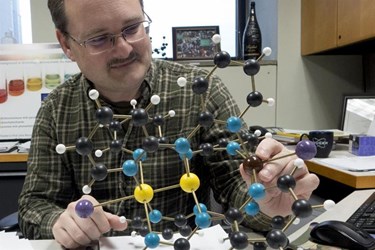Molecular magnetism packs power with 'messenger electron'

Atoms on adjacent molecules like this could be linked to form a long, magnetic chain, creating a new type of magnetic structure, says John Berry, a professor of chemistry at the University of Wisconsin-Madison
The spins of unpaired electrons are crucial to permanent magnetism, and after 10 years of design and re-design, research conducted by John Berry at the University of Wisconsin-Madison, has resulted in a molecule that gains magnetic strength through an unusual way of controlling those spins.
According to Berry the new structure, created by graduate student Jill Chipman could lead to a breakthrough in quantum computing.
The presence and activity, or "spin," of unpaired electrons sets the strength of a permanent magnet, so molecules with a high degree of spin are crucial. The unusually large spin in the new magnetic molecule, Berry explains, results from a "messenger electron" that shuttles between an unpaired electron at each end of the rod-shaped molecule and persuades all three of them to adopt the same spin.
That agreement of spin, termed "orthogonality", adds strength to a permanent magnet.
Berry, a UW-Madison professor of chemistry, notes that in other materials, a traveling electron tends to oppose the spins of magnetic centres, reducing the magnetic strength. In Chipman's work, however, the messenger electron causes the two remote unpaired electrons to take the same spin, adding strength and/or durability.
The new molecule, described in the journal Chemistry, contains carbon, nickel, chlorine, nitrogen, and molybdenum, but lacks the costly rare earth elements that have impacted on efforts to commercialise super-strong new magnets.
Its structure suggests that the molecule could be formed into a polymer - a repeating chain of units like those found in plastics - raising the possibility of cheaper, but much stronger magnets.
"We tried to remove electrons from this molecule 10 years ago so it had an unpaired electron at each end, but did not get far," Berry says. "We since learned that this made a chemical that is really temperature-sensitive, so we had to develop a low-temperature process that relies on dry ice to cool it to -780C."
The electron establishes "a design principle that could be used to create many new magnetic molecules that behave as little bar magnets," Berry says.
Much of the focus of magnet innovation concerns greater strength, Berry says, "but there are all sorts of things people look for. We need both permanent magnets and those with ephemeral magnetization for different technical reasons. Magnets are widespread in ultra-cold refrigeration, motors, computer hard drives and electronic circuits."
By going the next step, and miniaturising magnets to a single molecule, quantum computing could be enabled, Berry says.
在线留言询价
- 一周热料
- 紧缺物料秒杀
| 型号 | 品牌 | 询价 |
|---|---|---|
| BD71847AMWV-E2 | ROHM Semiconductor | |
| MC33074DR2G | onsemi | |
| TL431ACLPR | Texas Instruments | |
| RB751G-40T2R | ROHM Semiconductor | |
| CDZVT2R20B | ROHM Semiconductor |
| 型号 | 品牌 | 抢购 |
|---|---|---|
| BU33JA2MNVX-CTL | ROHM Semiconductor | |
| IPZ40N04S5L4R8ATMA1 | Infineon Technologies | |
| ESR03EZPJ151 | ROHM Semiconductor | |
| STM32F429IGT6 | STMicroelectronics | |
| BP3621 | ROHM Semiconductor | |
| TPS63050YFFR | Texas Instruments |
AMEYA360公众号二维码
识别二维码,即可关注
























